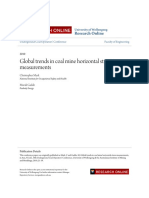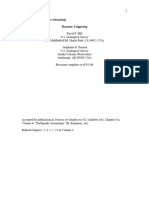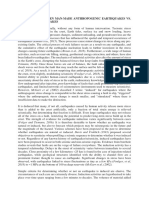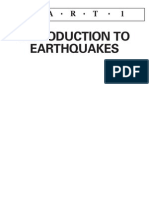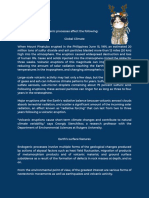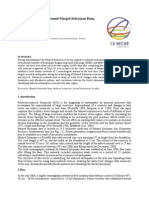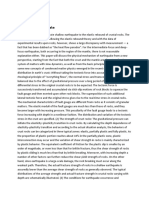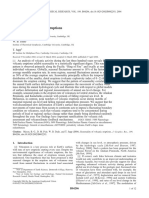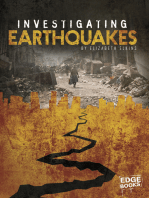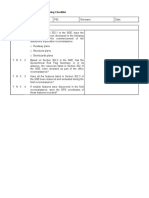Did An Earthquake Trigger The May 2006 Eruption of The Lusi Mud Volcano?
Did An Earthquake Trigger The May 2006 Eruption of The Lusi Mud Volcano?
Uploaded by
Aditya KurniawanCopyright:
Available Formats
Did An Earthquake Trigger The May 2006 Eruption of The Lusi Mud Volcano?
Did An Earthquake Trigger The May 2006 Eruption of The Lusi Mud Volcano?
Uploaded by
Aditya KurniawanOriginal Description:
Original Title
Copyright
Available Formats
Share this document
Did you find this document useful?
Is this content inappropriate?
Copyright:
Available Formats
Did An Earthquake Trigger The May 2006 Eruption of The Lusi Mud Volcano?
Did An Earthquake Trigger The May 2006 Eruption of The Lusi Mud Volcano?
Uploaded by
Aditya KurniawanCopyright:
Available Formats
Eos, Vol. 88, No.
18, 1 May 2007
Did an Earthquake Trigger the May 2006 Eruption
of the Lusi Mud Volcano?
PAGE 201
On 29 May 2006, a mud volcano, unofficially named Lusi, erupted in the Indonesian city of Sidoarjo, in eastern Java, covering an area of several square kilometers with
mud [Davies et al., 2007] and displacing
more than 24,000 people [Cyranoski, 2007].
Two days earlier, a magnitude 6.3 earthquake
occurred approximately 250 kilo-meters to
the southeast. A 2800-meter-deep exploratory
gas well, located about 200 meters from the
mud eruption, experienced control problems
within 57 hours of the earthquake (R. J.
Davies, personal communication, 2007) indicating changes in fluid pressures soon after
this earthquake. This earthquake is coincident with changes in eruptive behavior at
nearby magmatic volcanoes [Harris and
Ripepe, 2007; Walter et al., 2007]. Did the
earthquake trigger the eruption of the Lusi
mud volcano?
The eruption of mud volcanoes is one of
several possible subsurface hydrological
responses to earthquakes. Within less than
one or two fault lengths from the ruptured
surface, static stress changes cause expansion or contraction of the crust which in
turn can change pore pressure. Because
static stress changes decay with the cube
of the distance away from the main shock, at
the distance of the mud volcano (about 30
fault lengths away from the epicenter), static
stress changes are negligible. However,
dynamic stress changes caused by propagating seismic waves will be much larger at
such large distances. In unconsolidated sediments, if these transient stresses are large
enough and there are sufficient cycles of
deformation, grains can be rearranged into
a more compact arrangement leading to an
increase in pore pressure. If pore pressure
increases to the point that it can bear the
weight of the overburden, the sediment will
lose strength and behave in a liquid-like
manner. Such liquefaction is one way to
create mud volcanoes.
Figure 1 shows the relationship between the
distance of hydrological responses from earthquake epicenters as a function of the earthquake magnitude. These responses include
changes in stream discharge, the occurrence
of liquefaction, and the eruption of mud volcanoes from depths greater than a few hundred
meters. The mechanisms that lead to these
responses are varied, including liquefaction
and changes in permeability [Montgomery
and Manga, 2003]. Nevertheless, all responses
likely involve a permanent change in subsurface properties. The black line is an empirically drawn upper bound for these hydrologic
responses that also corresponds to a line of
constant seismic energy density [Wang et al.,
2006]. This line is best interpreted as the maxi-
mum distance over which the indicated types
of hydrologic response to an earthquake have
been documented, and, presumably, these
responses require optimal subsurface conditions and source properties: At distances
below the line, no hydrological response is still
the most common observation for most earthquakes.
Superimposed on this plot are data from
the Lusi mud volcano. The star in Figure 1
shows the distance between the magnitude
6.3 earthquake and the Lusi mud volcano.
This earthquake occurred at a distance well
above the line in Figure 1, that is, at distances
greater than we would expect to see the types
of hydrologic response shown in Figure 1. A
more convincing case that the earthquake
did not trigger the eruption can be made by
considering its noneruption in response to
previous earthquakes. The solid circles in Figure 1 show the magnitudes and epicentral
distances of regional earthquakes of magnitude greater than 6 since 1974. Only earthquakes with epicentral depths greater than
200 kilometers are included. Importantly,
there were two earthquakes (in 1976 and
1998) that were larger and closer to the Lusi
eruption, yet none, to my knowledge, triggered
a mud-volcano eruption. In addition, there
was a more distant magnitude 7.8 earthquake
that falls below the empirical maximum-distance-for-hydrologic-response line plotted in
Figure 1. No eruption was triggered.
The natural eruption of mud volcanoes
does not require earthquakes, and most eruptions are probably not triggered by earthquakes [Mellors et al., 2007]; tectonic compression, gas or fluid migration, and even ocean
waves can lead to liquefaction or can fluidize
unconsolidated sediments [e.g., Maltman and
Bolton, 2003]. All these processes lead to overpressure developing on the (long) timescales
that characterize the relevant geological process [Kopf, 2002]. If the system was so close to
critical that it began erupting in 2006, it is surprising that none of the events closer to the
empirical threshold line in Figure 1 triggered
an eruption.
Acknowledgment
The author is supported by the U.S. National
Science Foundation (EAR-0608885).
References
Cyranoski, D. (1997), Muddy waters, Nature, 445,
812815.
Davies, R. J., R. E. Swarbrick, R. J. Evans, and
M. Huuse (2007), Birth of a mud volcano: East Java,
29 May 2006, GSA Today, 17, 49.
Harris, A. J. L., and M. Ripepe (2007), Regional earthquake as a trigger for enhanced volcanic activity:
Evidence from MODIS thermal data, Geophys. Res.
Lett., 34, L02304, doi:10.1029/2006GL028251.
Fig. 1. Distance between the earthquake epicenter and hydrologic response as a function
of earthquake magnitude. Increases in stream
discharge, shallow liquefaction, and eruption of
mud volcanoes are shown with open squares,
triangles, and yellow circles respectively; data
are from compilations and references presented by Montgomery and Manga [2003] and
Wang et al. [2005, 2006], with mud volcano
data compiled by Manga and Brodsky [2006]
and from Table 1 of Mellors et al. [2007]. The
red circles show the distance between regional
earthquakes and the location of the Lusi volcano. The star represents the distance between
the Lusi mud volcano and the earthquake 2
days prior to the eruption. Earthquake locations and properties are obtained from the
U.S. Geological Surveys National Earthquake
Information Center catalog (http://neic.usgs.
gov/neis/epic/epic.html).
Kopf, A. J. (2002), Significance of mud volcanism, Rev.
Geophys., 40(2), 1005, doi:10.1029/2000RG000093.
Maltman, A. J., and A. Bolton (2003), How sediments
become remobilized, in Subsurface Sediment
Mobilization, edited by P.Van Rensbergen et al.,
Geol. Soc. Spec. Publ., 216, 920.
Manga, M., and E. E. Brodsky (2006), Seismic triggering of eruptions in the far field: Volcanoes and
geysers, Annu. Rev. Earth Planet. Sci., 34, 263291.
Mellors, R., D. Kilb, A. Aliyeev, A. Gasanov, and G.
Yetirmishli (2007), Correlations between earthquakes and large mud volcano eruptions, J. Geophys. Res, 112, B04304, doi:10.1029/2006JB004489.
Montgomery, D. R., and M. Manga (2003), Streamflow
and water well responses to earthquakes, Science,
300, 20472049.
Walter, T. R., R. Wang, M. Zimmer, H. Grosser,
B. Lhr, and A. Ratdomopurbo (2007),Volcanic
activity influenced by tectonic earthquakes:
Static and dynamic stress triggering at Mount
Merapi, Geophys. Res. Lett., 34, L05304, doi:10.1029/
2006GL028710.
Wang, C.-Y., M. Manga, and A. Wong (2005), Floods on
Mars released from groundwater by impact, Icarus,
175, 551555.
Wang, C.-Y., A. Wong, D. S. Dreger, and M. Manga
(2006), Liquefaction limit during earthquakes
and underground explosions: Implications for
ground-motion attenuation, Bull. Seismol. Soc. Am.,
96, 355363.
MICHAEL MANGA, University of California,
Berkeley; E-mail: manga@seismo.berkeley.edu
You might also like
- Relief Well Planning ChecklistDocument9 pagesRelief Well Planning Checklistbyed100% (2)
- Identifying Minerals Lab ActivityDocument3 pagesIdentifying Minerals Lab ActivityJasmine ButteryNo ratings yet
- Igneous RocksDocument1 pageIgneous RocksPerlita SanchezNo ratings yet
- Minerals and RocksDocument6 pagesMinerals and Rocksmarc7victor7salesNo ratings yet
- Shellyetal2013 YellowstoneDocument15 pagesShellyetal2013 YellowstoneclarklipmanNo ratings yet
- Causes For Triggered Earthquakes - A Recent Review: R.Samuel Selvaraj and B.UmamaheswariDocument5 pagesCauses For Triggered Earthquakes - A Recent Review: R.Samuel Selvaraj and B.UmamaheswariRakeshconclaveNo ratings yet
- Khwopa College of Engineering: Earthquake Triggered LandslideDocument16 pagesKhwopa College of Engineering: Earthquake Triggered Landslidesabin birbalNo ratings yet
- Global Trends in Coal Mine Horizontal Stress Measurements: Research OnlineDocument20 pagesGlobal Trends in Coal Mine Horizontal Stress Measurements: Research Onlinekatta_sridharNo ratings yet
- Seismically Induced Failure of Rock Slopes: Insights From Field Observations and Analytical ModelingDocument15 pagesSeismically Induced Failure of Rock Slopes: Insights From Field Observations and Analytical ModelingCătălin CăpraruNo ratings yet
- Prog Phys Geo 27Document19 pagesProg Phys Geo 27ghifariauliaNo ratings yet
- 2008 - The East Java Mud Volcano (2006 To Present)Document12 pages2008 - The East Java Mud Volcano (2006 To Present)faris nauvalNo ratings yet
- DownloadDocument61 pagesDownloadJosé Gabriel Almeida HerreraNo ratings yet
- A Review of Rockfall Mechanics and Modelling Approaches: Luuk K.A. DorrenDocument19 pagesA Review of Rockfall Mechanics and Modelling Approaches: Luuk K.A. DorrenmornewpNo ratings yet
- BBD - Chapter - 5 - Quatification of Seismic Force.Document25 pagesBBD - Chapter - 5 - Quatification of Seismic Force.Sandeep OadNo ratings yet
- Figure 1. Faulting Map of Mendoza City, Argentina (Segemar)Document22 pagesFigure 1. Faulting Map of Mendoza City, Argentina (Segemar)Francisco CalderonNo ratings yet
- HumanInduced Vs TectonicDocument3 pagesHumanInduced Vs TectonicNiptika JanaNo ratings yet
- Geophysical Research Letters - 2022 - Passarelli - Earthquake Fingerprint of An Incipient Subduction of A Bathymetric HighDocument11 pagesGeophysical Research Letters - 2022 - Passarelli - Earthquake Fingerprint of An Incipient Subduction of A Bathymetric HighRiska MajitNo ratings yet
- Lin 2013Document18 pagesLin 2013MatiasAedoNo ratings yet
- Soil-amplification-in-Adelaide Final ReportDocument21 pagesSoil-amplification-in-Adelaide Final ReportAshwin Muthuraman RamurathinamNo ratings yet
- Mohr - Structural Geology of Impact CratersDocument27 pagesMohr - Structural Geology of Impact CratersJorgeTrabajoNo ratings yet
- About EarDocument7 pagesAbout EarAbdul RazalNo ratings yet
- Chapter One - ThreeDocument42 pagesChapter One - ThreeHorpieyNo ratings yet
- Strasser 2010Document10 pagesStrasser 2010abeledwarNo ratings yet
- Introduction To Earthquakes: P A R T 1Document26 pagesIntroduction To Earthquakes: P A R T 1Tojo RanaNo ratings yet
- 14498Document27 pages14498Zig BlankNo ratings yet
- Endogenic and Exogenic ProcessesDocument18 pagesEndogenic and Exogenic ProcessesTiken TakhellambamNo ratings yet
- Earthquake-Induced Chains of Geologic Hazards: Patterns, Mechanisms, and ImpactsDocument83 pagesEarthquake-Induced Chains of Geologic Hazards: Patterns, Mechanisms, and ImpactselcioniwaNo ratings yet
- Solar System Planetary AlignmentDocument13 pagesSolar System Planetary AlignmentSyed Ali Raza NaqviNo ratings yet
- Cause and Effect Essay AssignmentDocument2 pagesCause and Effect Essay AssignmentRuzuiNo ratings yet
- Lecture 6 PDFDocument11 pagesLecture 6 PDFsunilaanserNo ratings yet
- Research Activity On Endogenic ProcessDocument2 pagesResearch Activity On Endogenic ProcessReign Ivan C. RefuerzoNo ratings yet
- Isacks Et Al., 1968Document45 pagesIsacks Et Al., 1968Tania G VerdiguelNo ratings yet
- Chapter 4 Quantification of Seismic AccelerationDocument5 pagesChapter 4 Quantification of Seismic AccelerationkkgbkjNo ratings yet
- Arcs Desilva Geology 08Document2 pagesArcs Desilva Geology 08Victor ValdiviaNo ratings yet
- Three Dimensional Mapping and Kinematic Characterization of Mass Transport Deposits Along The Outer Kunamo Basin and Nankai Accretionary Wedge Southwest JapanDocument19 pagesThree Dimensional Mapping and Kinematic Characterization of Mass Transport Deposits Along The Outer Kunamo Basin and Nankai Accretionary Wedge Southwest JapanZhang XueNo ratings yet
- Engineers EQHazDocument28 pagesEngineers EQHazGOATNo ratings yet
- Seismic Stratigraphy of The Hawaiian Flexural MoatDocument17 pagesSeismic Stratigraphy of The Hawaiian Flexural MoatEssn MuslimahNo ratings yet
- Coseismic Slip and Afterslip of The Great M 9.15 Sumatra-Andaman Earthquake of 2004Document22 pagesCoseismic Slip and Afterslip of The Great M 9.15 Sumatra-Andaman Earthquake of 2004Bobby WskNo ratings yet
- Matthewv 7 N 3Document37 pagesMatthewv 7 N 3sofienehaddadNo ratings yet
- Induced Seismicity Around Masjed Soleyman Dam, South West of IranDocument10 pagesInduced Seismicity Around Masjed Soleyman Dam, South West of Irangorgika papandNo ratings yet
- Guazaparez 2013Document35 pagesGuazaparez 2013jumapoloNo ratings yet
- Notes 8 Geology Notes Geology NotesDocument7 pagesNotes 8 Geology Notes Geology Notesmecajun1No ratings yet
- Amir Amirov E1111 (Zoning)Document13 pagesAmir Amirov E1111 (Zoning)Amir AmirovNo ratings yet
- Mechanism of EarthquakeDocument7 pagesMechanism of EarthquakeArslan RaoNo ratings yet
- Earthquakes: Soil DynamicsDocument21 pagesEarthquakes: Soil DynamicsJulNo ratings yet
- Seasonality of Volcanic EruptionsDocument12 pagesSeasonality of Volcanic EruptionsSudirman SamadNo ratings yet
- Assignment No. 1Document15 pagesAssignment No. 1daisyrediazurbanoNo ratings yet
- Evolution of Coseismic and Post-Seismic Landsliding After The 2015 M 7.8 Gorkha Earthquake, NepalDocument53 pagesEvolution of Coseismic and Post-Seismic Landsliding After The 2015 M 7.8 Gorkha Earthquake, NepalSharad WagleNo ratings yet
- Chapter 4 Quantification of Seismic Acceleration: 4.1 BackgroundDocument3 pagesChapter 4 Quantification of Seismic Acceleration: 4.1 BackgroundkkgbkjNo ratings yet
- THE GREAT PERMIAN EXTINCTION DEBATE. J. A. Marusek, Impact, (RR 6, Box 442, Bloomfield, INDocument2 pagesTHE GREAT PERMIAN EXTINCTION DEBATE. J. A. Marusek, Impact, (RR 6, Box 442, Bloomfield, INanilkumargkumar16No ratings yet
- 2022 Materna JGRDocument36 pages2022 Materna JGRhagerhossien36No ratings yet
- Walter, 2008 (Litelaur Sesar) (Faktor Pengendapan Sedimen)Document9 pagesWalter, 2008 (Litelaur Sesar) (Faktor Pengendapan Sedimen)Shadiq AliNo ratings yet
- Royalsoc PDFDocument18 pagesRoyalsoc PDFAndika Bayu AjiNo ratings yet
- Champagnac - 2012 - JGR - Tectonics, Climate, and Mountain TopographyDocument34 pagesChampagnac - 2012 - JGR - Tectonics, Climate, and Mountain Topographyantonio carlosNo ratings yet
- 10 1029@2019JB018681Document29 pages10 1029@2019JB018681Laura Osorio MoyaNo ratings yet
- EarthquakeDocument10 pagesEarthquakemuhammadumeryaqoob16No ratings yet
- EARTH 2 2nd Edition Hendrix Solutions Manual 1Document4 pagesEARTH 2 2nd Edition Hendrix Solutions Manual 1ronald100% (47)
- Global Review of Human Induced EarthquakeDocument18 pagesGlobal Review of Human Induced Earthquakekumar shivamNo ratings yet
- Eost17232 PDFDocument5 pagesEost17232 PDFgeotopgunNo ratings yet
- Vall-E Et Al-2013-Journal of Geophysical Research - Solid EarthDocument17 pagesVall-E Et Al-2013-Journal of Geophysical Research - Solid EarthDanielNo ratings yet
- EGEO 1 - Module 2 - Earth ProcessesDocument4 pagesEGEO 1 - Module 2 - Earth Processesshekaila.camisoNo ratings yet
- Clear Comfort Tech SheetDocument2 pagesClear Comfort Tech SheetAditya KurniawanNo ratings yet
- Cover Letter TemplateDocument1 pageCover Letter TemplateAditya KurniawanNo ratings yet
- Materi Pelatihan UniSimDocument34 pagesMateri Pelatihan UniSimAditya KurniawanNo ratings yet
- AXMFalconHeavy Arabsat6ADocument19 pagesAXMFalconHeavy Arabsat6AAditya KurniawanNo ratings yet
- Reliability of Core Analysis & PVT Data-3Document1 pageReliability of Core Analysis & PVT Data-3Aditya KurniawanNo ratings yet
- Revised Understanding of Transferring A Black Oil Model To CompositionalDocument9 pagesRevised Understanding of Transferring A Black Oil Model To CompositionalAditya KurniawanNo ratings yet
- SigitSukmono-Fundamental Seismic May'11Document2 pagesSigitSukmono-Fundamental Seismic May'11Aditya KurniawanNo ratings yet
- 2010meta Report Rubiales-Piriri Final - RevDocument46 pages2010meta Report Rubiales-Piriri Final - RevAditya KurniawanNo ratings yet
- Purpose: Under The Fall Protection Safe Work PracticeDocument4 pagesPurpose: Under The Fall Protection Safe Work PracticeAditya KurniawanNo ratings yet
- Questions and InstructionsDocument3 pagesQuestions and InstructionsAditya KurniawanNo ratings yet
- The Best EquationDocument17 pagesThe Best EquationAditya KurniawanNo ratings yet
- IndexDocument12 pagesIndexdaburto2No ratings yet
- IP Version 3.5 Release NotesDocument12 pagesIP Version 3.5 Release NotesAditya KurniawanNo ratings yet
- Purpose: Under The Fall Protection Safe Work PracticeDocument4 pagesPurpose: Under The Fall Protection Safe Work PracticeAditya KurniawanNo ratings yet
- Production Strategy For Thin-Oil Columns in Saturated ReservoirsDocument10 pagesProduction Strategy For Thin-Oil Columns in Saturated ReservoirsAditya KurniawanNo ratings yet
- Emulsion: TM-4144 Surface Facilities and Transportation by Leksono MucharamDocument37 pagesEmulsion: TM-4144 Surface Facilities and Transportation by Leksono MucharamAditya KurniawanNo ratings yet
- Earthquakes - PDF To Solve Class 9th IcseDocument4 pagesEarthquakes - PDF To Solve Class 9th IcseAyushmanNo ratings yet
- Hydraulic Calculation of Box Culvert: Wlu HC Hu C HLB Blu BLC WLCDocument1 pageHydraulic Calculation of Box Culvert: Wlu HC Hu C HLB Blu BLC WLCIwanTiaraMotorNo ratings yet
- Universal Transverse Mercator Coordinate SystemDocument7 pagesUniversal Transverse Mercator Coordinate SystemNanang SantosaNo ratings yet
- 2 Reconnaissance PlanningDocument3 pages2 Reconnaissance PlanningParthJainNo ratings yet
- A Geological Field Report On Rangamati-CDocument62 pagesA Geological Field Report On Rangamati-CFurious SKNo ratings yet
- SCALE-1:4,000 P.L. NO.-13/13 AREA - 363.89 Hactare Part of Toposheet No.-45 K/1Document1 pageSCALE-1:4,000 P.L. NO.-13/13 AREA - 363.89 Hactare Part of Toposheet No.-45 K/1Yash VermaNo ratings yet
- CBM SlideDocument28 pagesCBM SlideMARSHALLNo ratings yet
- BoholDocument23 pagesBoholchristelchico989No ratings yet
- Method Statement Rev 00 - Geotechnical InvestigationDocument35 pagesMethod Statement Rev 00 - Geotechnical Investigationenjazco.rsg100% (1)
- Alsinawi 2Document22 pagesAlsinawi 2Noor AdnanNo ratings yet
- Contoh Log BorDocument14 pagesContoh Log BorAbudzar AmnaNo ratings yet
- Actlabs - Schedule of Services - Canada 2016 (03-02)Document44 pagesActlabs - Schedule of Services - Canada 2016 (03-02)Anonymous iq67rN8A150% (2)
- Volcanic AshDocument2 pagesVolcanic AshplunitaNo ratings yet
- 11 Atlas Copco MAI Self DrillingDocument2 pages11 Atlas Copco MAI Self Drillingveni jesiaNo ratings yet
- Concret Technology 2 Mark QaDocument11 pagesConcret Technology 2 Mark Qasaty1049No ratings yet
- The Routine of Landform Geodiversity Map Design For The Polish Carpathian MtsDocument11 pagesThe Routine of Landform Geodiversity Map Design For The Polish Carpathian MtsPedro LópezNo ratings yet
- HYBRID CURRICULUM FINAL Updated 1Document97 pagesHYBRID CURRICULUM FINAL Updated 1EFren N. NOceteNo ratings yet
- CE 414, CE4B, August 2022Document25 pagesCE 414, CE4B, August 2022Roque III JaguioNo ratings yet
- Module 25 - GeoresourcesDocument35 pagesModule 25 - GeoresourcesKelompok T.72.74.KNo ratings yet
- Slideshow ApesDocument14 pagesSlideshow Apesapi-254428474No ratings yet
- Geology of GhanaDocument61 pagesGeology of GhanaKathlyne Pinkrah100% (1)
- Gog & Magog - M. Imran FaruquiDocument48 pagesGog & Magog - M. Imran FaruquibmphenriquezNo ratings yet
- The Challenge of Producing and Stimulating A Deep Sandstone-Carbonate Reservoir With Combined Organic and Inorganic Formation DamageDocument21 pagesThe Challenge of Producing and Stimulating A Deep Sandstone-Carbonate Reservoir With Combined Organic and Inorganic Formation DamageMiguel Angel GonzalesNo ratings yet
- S11ES IIc D 29Document3 pagesS11ES IIc D 29allanrnmanalotoNo ratings yet
- Pumping PrinciplesDocument384 pagesPumping PrinciplesMahmoud I. Mahmoud100% (1)
- Desert Magazine 1977 JanuaryDocument48 pagesDesert Magazine 1977 Januarydm1937No ratings yet







